|
 Dwight Peck's personal website Dwight Peck's personal website
Trento and Brescia, December 2013
A week's sightseeing in the Trentino-Alto Adige autonomous region and Brescia in Lombardy
You may not find this terribly rewarding unless you're included here, so this is a good time for casual and random browsers to turn back before they get too caught up in the sweep and majesty of the proceedings and can't let go.
Bolzano
We've been over the Simplon Pass, braved the horrific truck traffic on the Milan-Venezia autostrada, made our way up along the river Adige to Trento, and settled into the charming, rustic Locanda del Bel Sorriso. Today's sightseeing agenda includes Bolzano.

We're contentedly motoring on the A22 northward up the Adige valley, towards the Brenner Pass ultimately, anticipating a fine day's sightseeing in Bolzano (or should I say Bozen?).

We're driving about 45 minutes northward, and the mountains are getting mountainier on either side.

Our carpark in Bolzano happens to be adjacent to the Schloss Maretsch (or Castel Mareccio), which is a compact little castle dating from the 13th century and a Congress Centre, dating from the 20th.

We get to take the "mini-tour" for a small fee -- to see more of the place we would need to book "concerts, weddings, and conferences".

The central courtyard, with a convenient plastic rain-covering over it
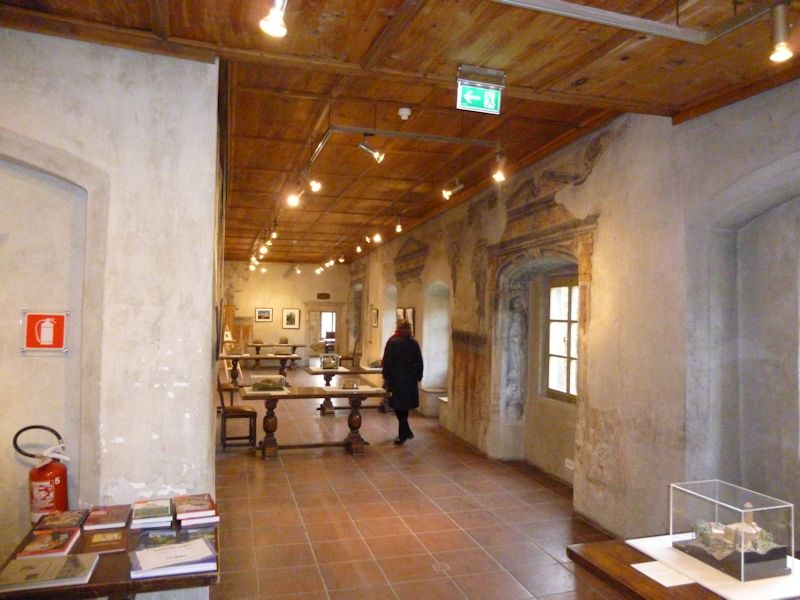
The front "Thun Hall" on the first floor, with displays of models of castles both in the region and all over Italy (including Castel del Monte in Apulia).

Frescoes

One of the round towers -- either the "Lukas" or the "Kaspar".


Castel Mareccio views

It's an exceedingly beautiful 13th century conference centre.

Another hall of frescoes (suitable for up to 76 conferees)

We'll be back (we've left the car in the parking lot here).

The Sacred Heart of Jesus church as we're walking towards the town centre. It was built in 1897 to look "Neo-Romanesque".

It certainly does look neo-something.

Signs of civilization as we near the city centre

The main east-west commercial street

The Piazza delle Erbe (or Obstplatz), and the fruit-and-vegetable market is electric with commercial vitality. Unlike Trento to the south, Bozen was 96% German-speaking when the region was annexed by the Italians after WW1, and even after Mussolini's "Italianization" settlement programme of southerners into the region, both languages are current here now (though 74% Italian). As the capital of the autonomous Italian province of Süd-Tirol, the German-speaking minority's interests are protected by statute.

The Piazza delle Erbe -- on the far side of the square begins the Via dei Portici or Laubengasse, or Street of Arcades, which runs 300 metres eastward through the centre of town (lots of upscale boutiques).

A statue of Neptune amidst the piles of artisanal jams and fresh turnips

You name it; we've got it.
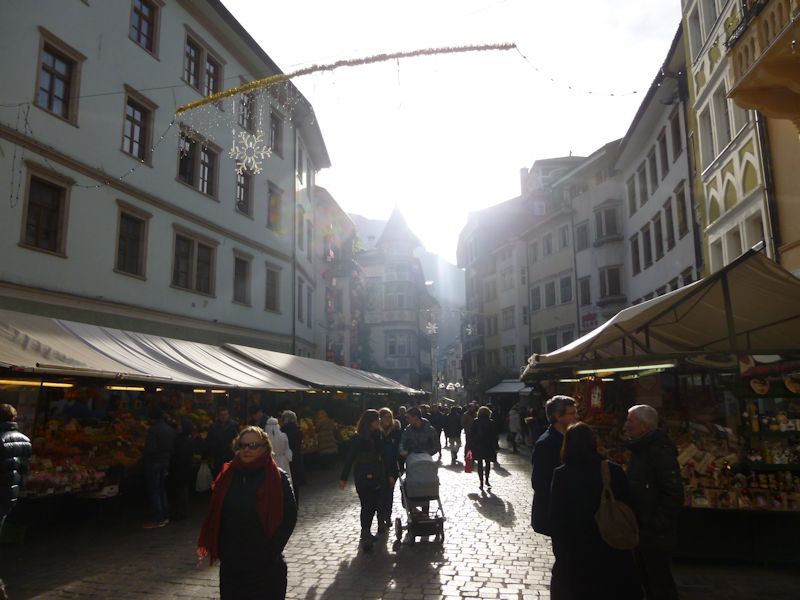
Getting and Spending on a chilly morning

The market evidently covers the whole side of town -- that's a lot of fresh turnips.

Bolzano was part of the ancient Rhaetian culture of eastern Switzerland and southern Germany, amongst whom the Romans planted a military settlement in 15 BC to cover the passes over the Alps to the north. In the 5th century, Theodoric's Ostrogoths inherited the region from the slow dissolution of the Western Roman Empire in Ravenna, and the Longobards, or Lombards, and their 'barbarian' buddies flooded in mostly unopposed from the Hungarian plains of Pannonia in 568.

The Longobards didn't advance the level of culture a whole lot, in fact, quite the contrary, at least at first, but they were here for a long long time. In fact, they were all over northern Italy for two centuries, until Charlemagne's Franks came along in the north in 774, and they were as far south as their duchies of Spoleto and Benevento until the Normans made them stop arranging matters and collecting taxes there in the 11th century.
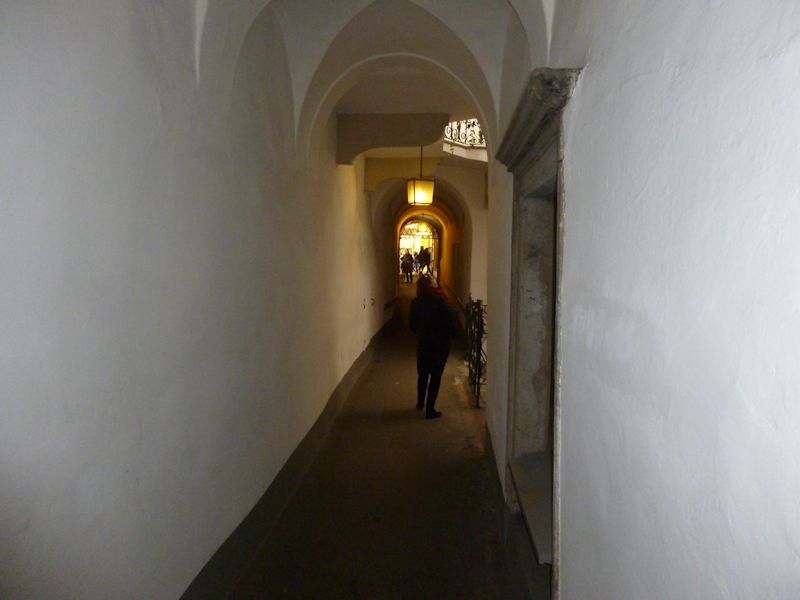
Back to the Laubengasse through an under-building passageway. The bishops of Trento awarded Bolzano the status of a market town in the late 12th century, and it flourished thereafter as a stop on the major north-south trade route to Germany and Bohemia. German-speaking Bavarians and Austrians were drawn into the region to get in on the commercial advantages.

How like the traboules of Lyon.

We've come to the Palazzo Mercantile to see the local artist Ulrich Glantschnigg (1661-1722), but luckily it was closed.

The Laubengasse -- this, in effect, was the original 'market town', impressive in its size for the time.

A few blocks southward, here's the famous Piazza Walther -- and another market.

The kid has made her choice.
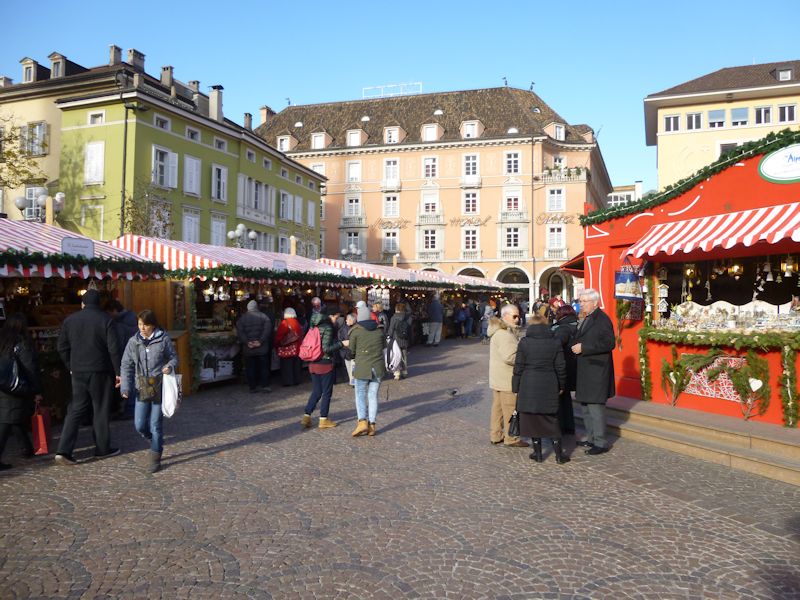
The Bolzano Christmas Market in the Piazza Walther

Perhaps that's Walther now.

And so it is. Walther von der Vogelweide, the famous early 13th century German minnesinger, or minstrel, and lyric poet. The statue dates from 1877 and perhaps there's a good reason why it's here, rather than in Vienna or Würzburg or someplace.

The duomo on a grey day

The cathedral was begun in the 1180s and completed in the 16th century, so there was plenty of time to experiment with a variety of styles.

Very nice so far

It's certainly got all the usuals.

The world's largest Advent Calendar

Kristin and the Lion's Mouth (the Venetians have been here)

A spiritual message, or a Bleak Vision of the Future?

Tyrolean cuisine (and pizza)

Neat

Yum. This is Walter and Michi's Würstelstand. (There goes my diet.)

Street scene

Back to the street markets


The Laubengasse again

At the far end of it, the Rathaus or city hall . . .

. . . with a brocante market just setting up for the afternoon (or closing down from the morning).

A city gate of some sort
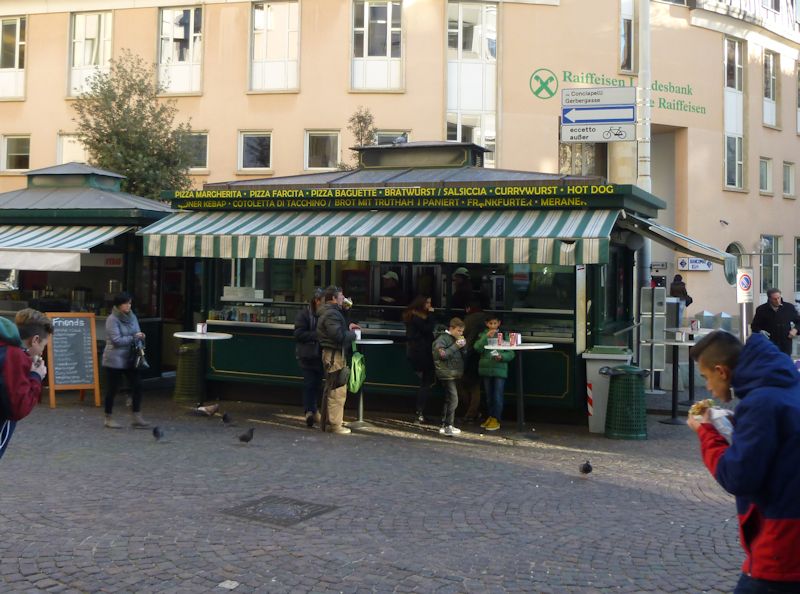
You can keep your Pizza Baguette and your Bratwurst. I'll have the Currywurst!

A shopping mall (not medieval)

Back to the Christmas market in the Walther-Platz


-- God, that looks like fun.

-- No, it doesn't. Come on.
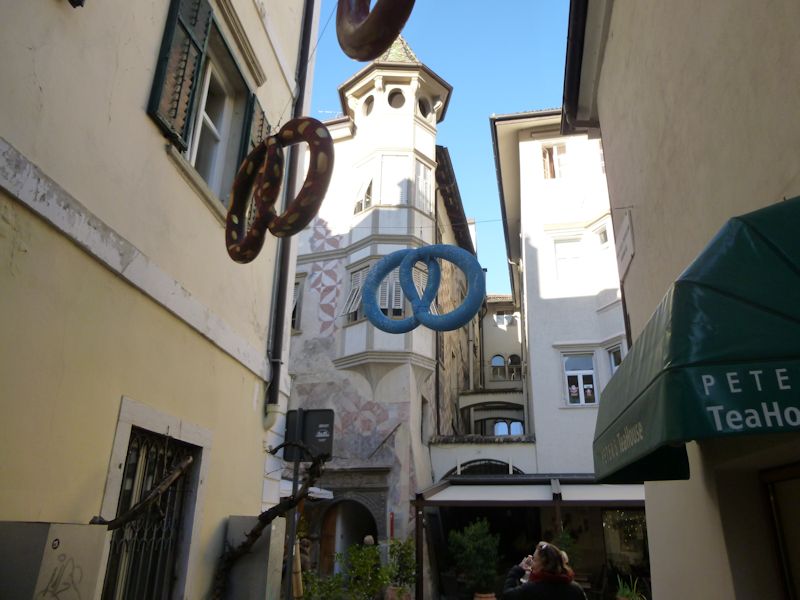
Flying pretzels

The Christmas spirit (artisanal beer, yay)
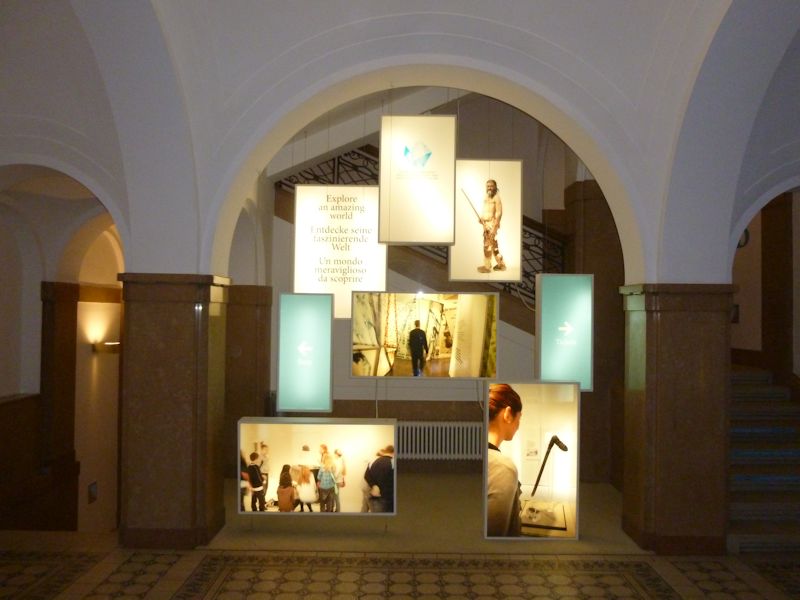
We're in the South Tyrol Museum of Archaeology (Museo archeologico dell'Alto Adige), which was established in 1998 in an old bank building to accommodate Mr Ötzi.

That's Ötzi, or some kind of forensic representation of him. Hikers found him washing out of a melting alpine glacier in 1991, at 3,200m up in the Ötztal Alps, and his climate-controlled mummy and his equipment have vastly illuminated modern knowledge of Copper Age life here in about 3,300 BC. He'd been shot in the back by persons unknown. Questions remain.

The museum's presentations of the science of Ötzi and the life of people here in the southern alpine foothills are brilliant. There's an interactive section for kids as well. And you can peek in at the real Ötzi himself, but eewww.
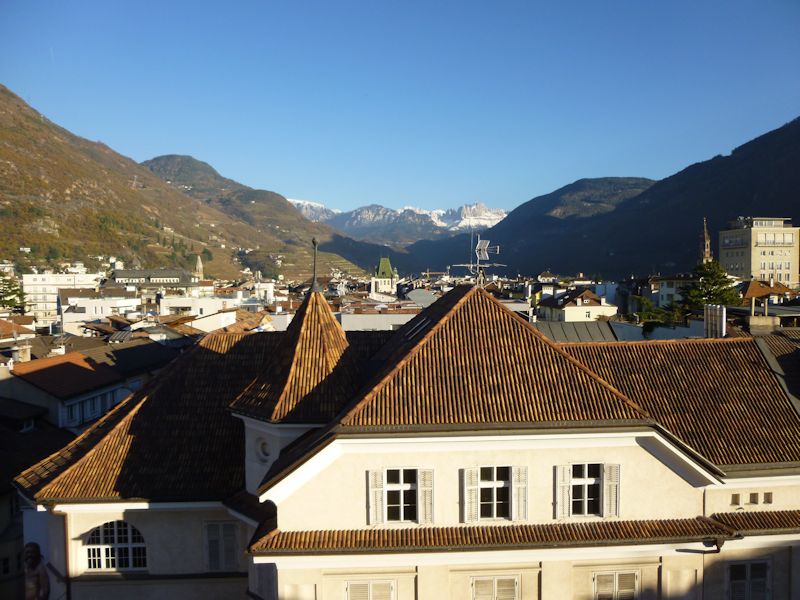
We're up the tower of the Civic Museum across the street, checking out the Roofs of Bolzano

More roofs (or rooves) and an unidentified church

There are the beginnings of the Dolomites over there to the east.

That's the "Victory Monument". It was set up by Mussolini in 1928 in order to infuriate the German-speakers who hadn't emigrated by then. It's fenced off to discourage any more defacements.
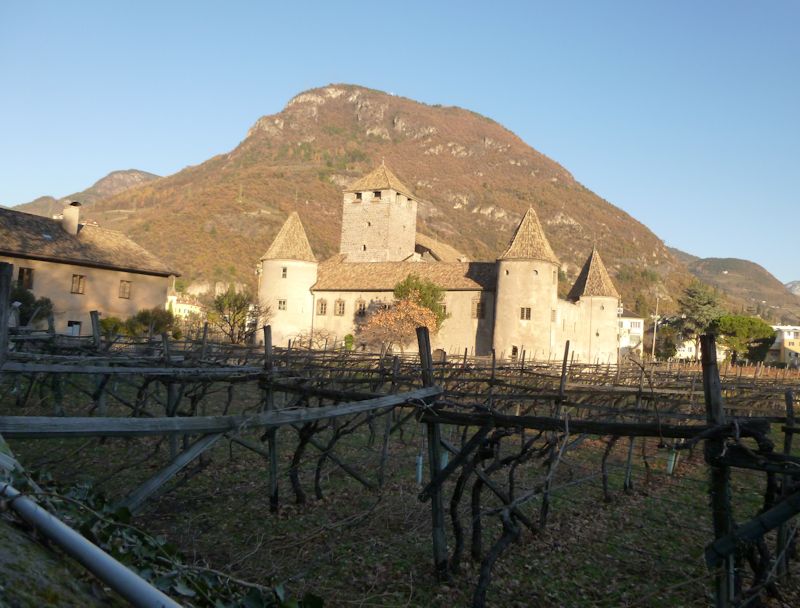
Ah, back to the Castle of Maretsch

An exemplary castle, and conference centre as well, of course

We left the car round here somewhere.
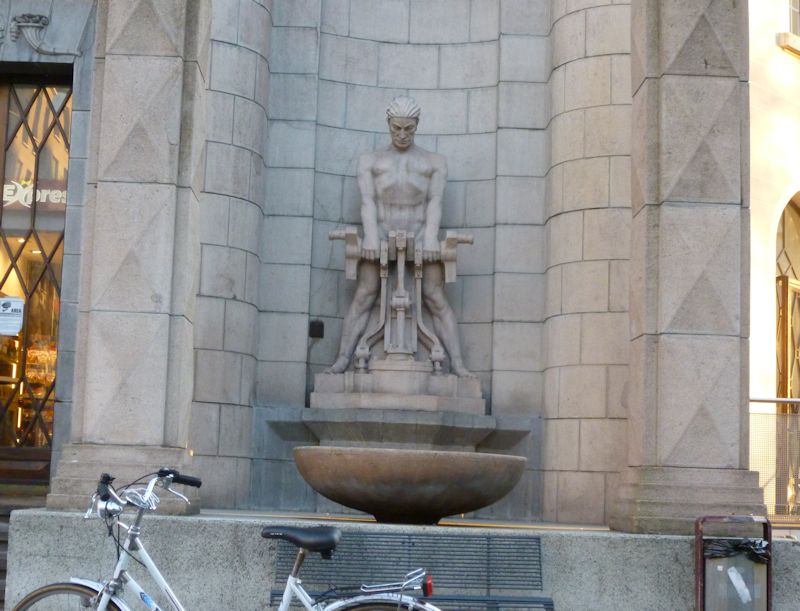
The city's railway station -- and the hand of Mussolini again, surely.
Next: Brescia.
Just so you know -- Bolzano's American football team is called the 'Bolzano Giants'.
        

 Feedback
and suggestions are welcome if positive, resented if negative, Feedback
and suggestions are welcome if positive, resented if negative,  .
All rights reserved, all wrongs avenged. Posted 18 January 2014. .
All rights reserved, all wrongs avenged. Posted 18 January 2014.
|
 Dwight Peck's personal website
Dwight Peck's personal website 





































































